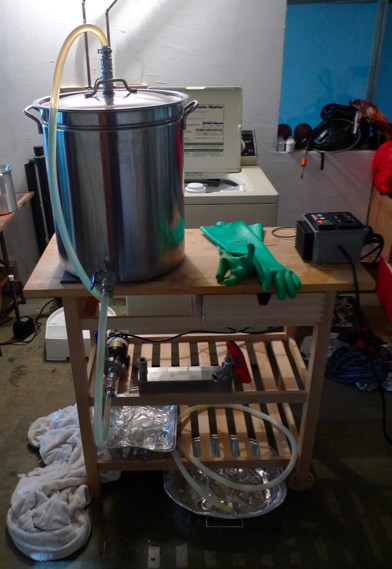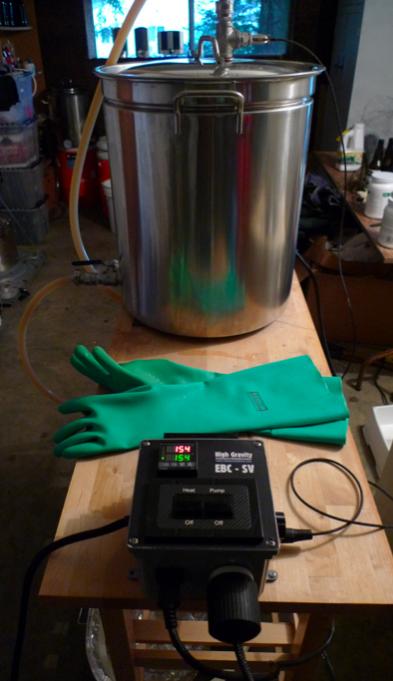YNOT2K
Well-Known Member
4 prong here too.

SanMarzano said:u can GFCI a 3 prong?
Yes you can. A friend of mine who is a master electrician installed it. It is a 50 amp GFCI protected spa panel that I bought off eBay for $40 a few months ago. The 3 prong outlet is hooked up to that.















SanMarzano said:Standard 220V, 30A 3-Prong "Dryer" Plug with 6 ft. cord. GFCI type breaker cannot be used with the 3-wire model. Order the 4-wire version with separate neutral and ground to support a GFCI installation.
I think this is due to 240 being split into 110 in the controller and neutral is needed to GFCI the 110 side as well? Thats my guess
The only place I would be able to brew is in the garage with the doors closed so the neighbors can't see what I'm up to.
You can pick your friends but you can't pick your neighbors.So your neighbors hate awesomeness?
Or perhaps they like it too much and dip into your supply too much?
You can pick your friends but you can't pick your neighbors.
Just my luck I'll have either end of the spectrum the neighbor on the left hates the smell of brewing beer while the neighbor on the right loves drinking my homebrew. Either way I'm not used to attracting a crowd during brewday, close friends and family excluded of course. I guess I'm just an introverted indoor basement brewer at heart.
I did my test run today with water. Below is what I noticed;
1)Check all fittings I had issues primarily on the lid where the T fitting meets the lid and the thermo coupler
2)As noted by someone else the mash temp fluctuates 2-3 degrees higher than the set point. This can be adjusted by lowering your set point by a degree or two
3)the controller has a slight buzz, anyone else hear that?
Test run was with 6 gallons of water at 84 degrees
a)Took 16min to get to 156 degrees and 31min to get to a boil
b)Evaporation was 1.5 G per hour (doe that seem right?)
Looking forward to brewing on it soon
Definitely check the fittings. If others end up getting this system, save yourself some pain and disassemble the fittings, throw a couple wraps of teflon tape on there, and re-tighten it. I've had no issues after doing that and I've got about a dozen batches on the system now.
As for your other observations, I've recently discovered a lot depends on where you've got that analog dial set. Based on your times and evap., my guess is you have it cranked. I do that to come to mash temp and go to boil, but I've found you need to feather it down to better control the mash. I think that's why it seems to overshoot so much. I took the dial down between 1/2 to 2/3 during my last batch and it held temp much better. When I had it too low, it actually was missing on the low end. So the sensitivity could certainly be tuned better, but you can adapt with the analog dial.
I also don't have it going full out on the boil. I took it up to where I get a nice boil and made a mark that's probably around 2/3 to 3/4 full. At that setting, I have a steady boil, but only get about 1 gal/hr evaporation. If you've got it full tilt, 1.5 gal/hr sounds right. I think I tried that once. No reason you can't do that I suppose if you plan for it, but I was concerned about the extreme boil causing junk to build up on my element.
One other reason I love this system. On my last couple batches, I was having an issue where my sprayer tip was coming loose. No big deal and I put it back on. Well on my last time, I cross-threaded it and ruined it. I went to High Gravity to ask for a replacement. Even despite telling them it was my own dumb ass that broke it, they sent me a replacement assembly no charge. Can't beat that customer service.
kzimmer0817 said:OK. I hate to keep asking the same questions, but . . . how are folks enjoying their High Gravity Electric BIAB system? Any new kinks to iron out? How is the EBC-SV controller working out? Are you still using the basket and is it draining well for you? I should be ready to restart brewing in a few months as I get some other projects going around the house - including some plumbing and electrical work. Thanks, Keith


NWMushroom said:It can get a little steamy, but nothing major. If I owned the place I'd look at getting a vent installed, but I only rent so...
You should at least put a fan in there for your landlords sake
My basement is actually above ground. I have 4 large windows and with the door open there's great airflow. I don't think it's a big deal TBH.
Your mileage may vary.
I bought their system, but added my own pump (with ball valve) and a plate chiller.
I opted for the silicone tubing and I also requested stainless steel quick connectors instead of the polysulfone quick connectors that come in the standard package.
I dont have this system but I have a very similar system with the ball valve before the pump and I am able to control the flow just fine. I dont believe it has to be after the pump. Just an FYI in case that helps anyone.